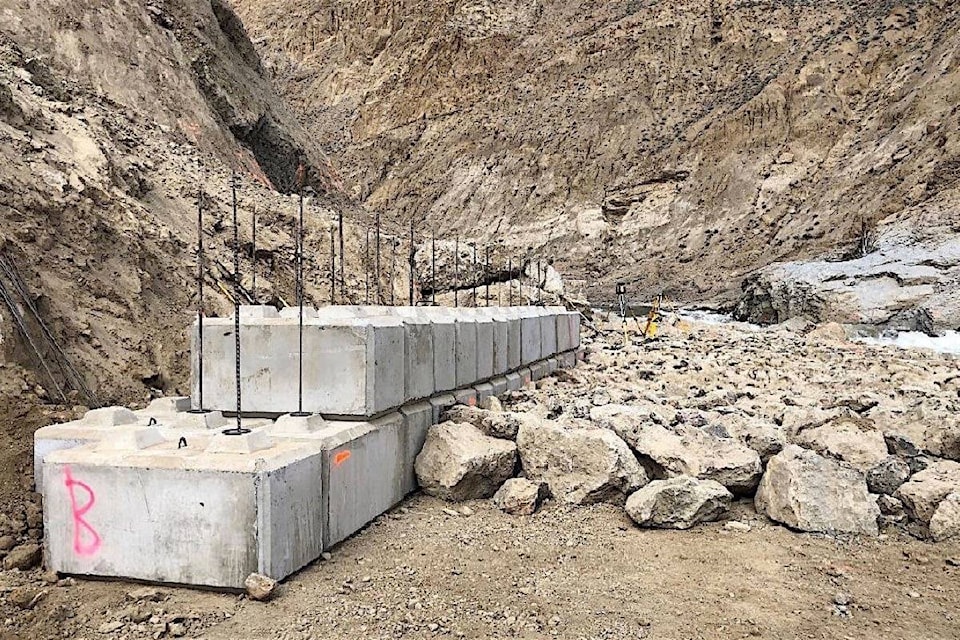There’s cautious optimism at the Big Bar landslide site on the Fraser River, as officials prepare for the first salmon to arrive in late May with a pneumatic “fish cannon” to get them past the slide.
The fish pump is one of a series of possible measures planned to help move the spawning fish past the blockage, said Gwil Roberts, director of the landslide response team for Fisheries and Oceans Canada.
“Obviously we want to see fish passage completely restored,” Roberts said on a conference call April 27. “If they can’t move across the slide this season, we will have measures in place to help them across.”
At the same time, water levels are rising fast with spring freshet at the site in the Fraser River north of Lillooet.
Last summer the massive rock slide was discovered after a part of the canyon cliff sheared off and fell into the river. That created strong flows, a powerful waterfall, and an obstruction in the river that prevented thousands of migrating Fraser River salmon from making it to their spawning grounds.
Remediation measures include building a “nature-like” fishway with huge boulders, and construction of a fish ladder alongside a pneumatic “fish cannon” that will “whoosh” fish above the river in tubes and move them upstream.
Asked what percentage of fish would likely make it past the site this summer, Roberts said it was impossible to predict and they will only know by the end of the summer. The bulk of salmon spawners won’t arrive until the fall.
Massive boulders measuring two metres wide that make up the “fishway” are designed to create pools in between for the fish to rest in. But they only work at low water, however and are now completely covered with the start of freshet over the past week.
“We hope it will be well used eventually,” Roberts said. “Fish are not at the site right now, by the way. They normally arrive in late May.”
The slide has led to huge mortalities from key Fraser salmon stocks, such as chinook and early stuart sockeye, which are already a conservation concern.
Construction of the fish ladder is now underway in-river using about 500 concrete blocks. The ladder is a fish delivery system planned for May to August, to help artificially lift the fish into a holding area. From there a pneumatic fish pump, the “fish cannon” collect them from holding pools and “whoosh” them through a series of tubes to the upstream part of the river.
“If we can’t use the fish pump, we will transport them by truck upstream of the slide site,” Robert said.
They are working in earnest to plan to help move fish with these measures, Roberts said, but ultimately they want them swimming past the slide on their own volition.
READ MORE: Work at Big Bar a race against time
Water levels are coming up steadily with spring freshet for the past week, Roberts noted, which is a concern. They were “blessed” with low water levels over the winter construction period.
Prime contractor Peter Kiewit & Sons had a “very successful three months,” of drilling and blasting, Roberts said, as they had been on-site since January.
READ MORE: Long-awaited blasting started in February
Work by the contractor included punching in a road on the west side in extremely difficult terrain, removing large boulders and reducing the outcropping known as the ‘east toe’ using stringent safety standards in hazardous rockfall conditions.
The huge volume of water, and the five-metre waterfall, were factors in preventing salmon from getting across the slide last summer.
That triggered a tripartite joint effort in July 2019 by federal and provincial officials and First Nations to clear the obstruction.
The remediation measures being introduced are an effort to help fish get over the blockage if natural fish passage is once again obstructed.
The site is on the traditional territory of the Secwepemc Nation, specifically High Bar First Nation and Stswecem’c Xgat’tem First Nation. A First Nations panel has been involved in the decision-making from the start.
Contingency planning for the enhancement of stocks returning to the upper Fraser watershed is also ongoing. A monitoring program throughout the salmon migration period will gather as much information as possible and to aid the implementation of the contingency plans.
A trap-and-transport option is also being planned to scoop up salmon below the slide and release them up river if need be.
For more see DFO’s Big Bar Landslide Response webpage or the Province of B.C.’s Big Bar Landslide Incident webpage.
Do you have something to add to this story, or something else we should report on? Email:
jfeinberg@theprogress.com
@CHWKjourno
Like us on Facebook and follow us on Twitter.



